How to design courses for actual learning - stepping on the shoulders of others

The different practices of teaching and research
Let’s do a thought experiment: What if there would be a “Google Scholar for teaching”? Imagine a search engine for educational methods based on proper psychology of learning - not having to invent the whole course from scratch by ourselves.
We could look up for handy methods for warming up the class or proven tools for assessment of learning. We’d have an educational process or method like we have the scientific method to follow. If someone then told that she is not using the search engine, not building upon other educators’ proceedings, she would be considered unprofessional.
Maybe one day, we’ll have this neat search engine for applied educational findings. In the meantime we can learn from this thought experiment: If such a search engine would exist, we would definitely suggest everyone use it - so why are we not building on top of each other's work now when it comes to teaching?
Where to find tools for planning and teaching?
Perhaps the reason for this difference between research and teaching is that there is a vast number of specialized platforms for sharing the research findings, data and methods - but in education, few or no such platforms exist. Stepping on the shoulders of giants in teaching is hard when no giants are insight.
While we are waiting for the revolutionary search engine, a recent development in the field of education and professional development can prove helpful. One way of building teaching on top of what others have created is to use specific learning design processes. The practice of instructional design, and it’s more recent update learning design, has been around, especially in Northern America from the 1950s on.
Learning design practices make use of pre-formulated processes that guide the teacher through planning, design, implementation, and finally, assessment of a course. This way, the teacher can focus on the actual content and interaction.
Open-source tools for learning design
Some open-source tools for learning design to start with:
- Aalto Teaching Lab Design Kit (deck of cards) & other Good Practices
- FITech Learning Design Toolkit (set of canvases/worksheets)
- Learning Design Cards by Marion Gruber (deck of cards)
- Learning design playbook (in Finnish) by eOppiva (canvases + guidebook)
Teaching for actual learning
Following the process provided by these tools lets the teacher focus on the content and developing the teaching, not having to worry whether everything has been considered or not. The readymade tools guide you to ask the right questions.
There is more time for considering the actual learning in the course, more time to interact with the learners, more possibilities for building a course that connects the learning into the actual world - thus improving learning outcomes.
In my personal opinion, structuring the planning and design of teaching is the best way to make way for actual learning. Without these wireframes, we tend to focus too much on what should be learned, not on how people actually learn it. As the process guides us to take into account, we are able to make learning more meaningful. This could mean for example connecting the course topics more into generic themes and competences, such as entrepreneurship, sustainability, communication and people skills. Real-world relevance makes learning meaningful both to the learners and teachers.
Author:
The author works as a learning designer in team FITech. Akseli’s ambition is to make learning meaningful and engaging, both online and on-campus.
Read more news

DeployAI Partners Gather for Heart Beat Meeting in Helsinki
The European DeployAI project's partners gathered for the Heart Beat meeting hosted by Aalto University Executive Education in Helsinki.
HRH Princess Maha Chakri Sirindhorn of Thailand visited Aalto University
During the visit, HRH and her delegation met with Aalto students and explored various activities.
Online AI course could boost study equality
Students at the School of Business believe that mastering Artificial Intelligence (AI) can be beneficial for both academic success and career prospects, as AI becomes increasingly integrated into daily life.